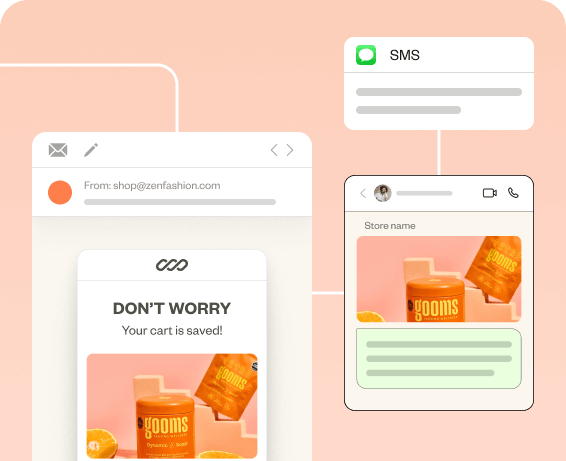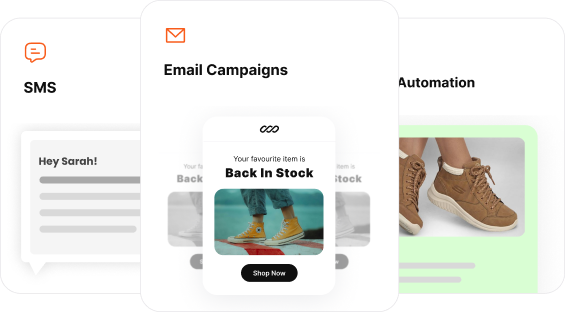There’s no single answer to how long a newsletter should be. Too short, and your newsletter might not provide enough value; too long, you risk losing your readers’ attention. Since newsletters are all about maintaining relationships, what’s the use if your’s is not engaging? Misses the entire point, right?
That is why the length of your newsletter is as important as its content. Finding the right newsletter length is essential to maximizing engagement, open rates, and overall retention of your subscriber base.
If you are unsure about your newsletter’s length, go through this article. Here, we’ve broken down the ideal newsletter length along with the factors that determine it.
Segment your audience and send personalized email newsletters to them that increase customer retention using Retainful.
What Research and Data Say About Newsletter Length?
Statistics indicate that more than 81% of people use mobile apps to read email newsletters, resulting in higher engagement rates. On the other hand, longer newsletter formats (400-700 words) do achieve higher engagement rates, particularly when targeting B2B audiences.
Learn More: What is a Newsletter? (How to Create + 5 Examples)
This indicates there’s no ideal length for your email newsletters. Sometimes you need to keep your newsletters short, while in other cases, they need to be longer. It’s all about who your audience is and what action you want your readers to take.
Since the reading speed of an adult is about 200 words per minute, and takes 51 seconds to read a newsletter. This indirectly indicates that you should keep your newsletter to under 200 words to get your readers’ full attention span.
Though following data and trends can make your email newsletter campaign work, only to some extent. So, marketers follow a test-and-learn approach to find out how long their newsletters are.
Do small ecommerce stores require newsletters?
Absolutely. Small eCommerce stores require newsletters to engage their customer base. Personalized email newsletters can increase engagement rate by 14% and conversion rates by 24%.
Types of Newsletters and Their Length
Newsletters, an essential part of email marketing, come in different lengths. Some are a mere 50 words, while some stretch beyond 200 words. The type of email newsletter, along with its word count, is listed in the table below.
| TYPE OF EMAIL NEWSLETTER | RECOMMENDED LENGTH |
| Weekly Newsletters | 100-200 words |
| Monthly Newsletters | 300-500 words |
| Promotional Newsletters | 50-150 words |
| Educational Newsletters | 500-1000 words |
| Transactional Newsletters | 50-150 words |
| Event Newsletters | 200-400 words |
| Customer Loyalty Newsletters | 150-300 words |
| Curated Loyalty Newsletters | 300-600 words |
| Company/Brand Announcements | 200-400 words |
| Survey/Brand Announcements | 100-250 words |
| Product Update Newsletters | 150-300 words |
| Welcome Emails/Newsletters | 150-300 words |
Learn More: 15 Best Ecommerce Letters to Follow in 2025
How Long Are Newsletters In Different Niches
Several factors determine the optimal length of your newsletters. One important factor among them is the niche. If the product itself is self-explanatory (Food, Clothes) or already popular, a more straightforward newsletter is sufficient.
On the other hand, a complex product requires a more detailed newsletter. Some of the best newsletter templates from different industries are shown below.
1. Food: Dominos
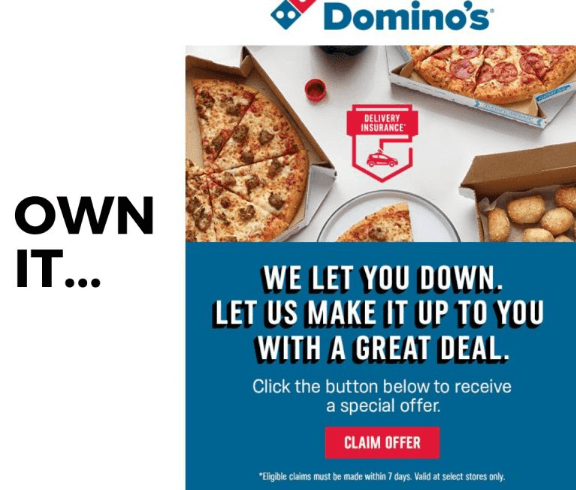
Although not a proper newsletter per se, Pizza emails, or any emails related to food, often look like this.
Since these are products that sell themselves, their content can be kept short (or even very short), urgent, and with a focus on offers on CTAs. They have high-quality food images along with offers to tempt readers.
Learn More: 9 Great Call to Action Examples for Your Ecommerce Store
Newsletters such as these must focus mainly on displaying the offers clearly to the readers.
Deliver your email newsletters consistently by scheduling them at the right time and creating automated workflows using Retainful.
2. Clothing: Adidas
If you are an ecommerce clothing store, this is how your newsletter should be. Here’s a sample newsletter from Adidas. In this, you can find the clothes neatly displayed along with styling tips, and sometimes a bit of information about the fabric or that piece of clothing.
If required, you can provide a brief product description too, with a focus on new arrivals and promotions focused on driving purchases.
Overall, the clothing newsletter’s length didn’t exceed 100 words.
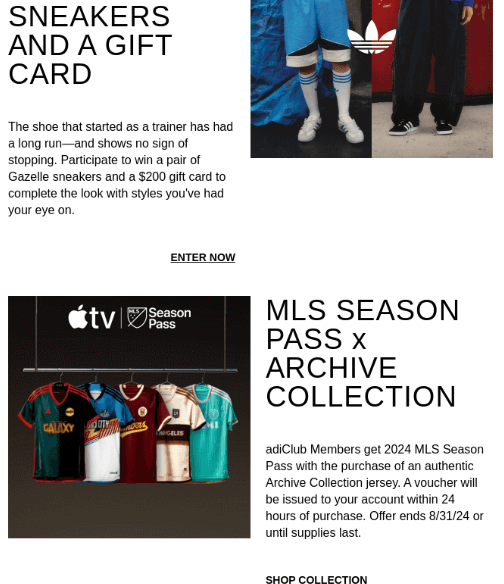
3. Accessories: Misfits Market
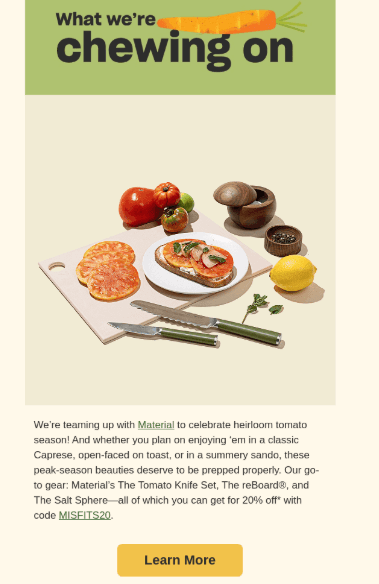
Here, the subject line is catchy and implies the sender has carefully curated an item for the customer.
Even though the product is a knife set and a chopping board, they’ve grabbed customer attention by describing them as ‘Season Essentials’ and making them visualize the product.
Then, they end the newsletter with a clear ‘Learn More’ button that takes the user to the purchase page. Overall, they’ve kept the size of the email newsletter to around 100 words.
4. Home Decor & Improvement
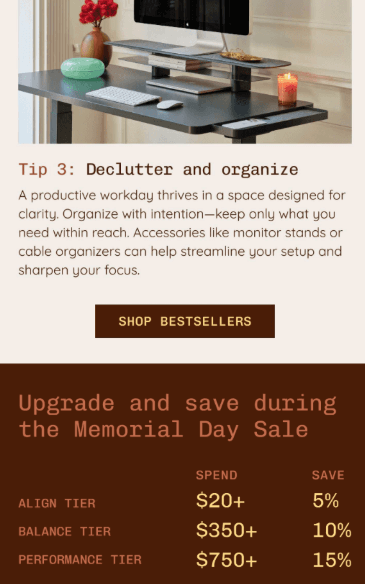
This one’s what I call a perfect email newsletter length. Most ecommerce stores that sell home essentials follow this template. This email newsletter is sent by an online store selling workspace furniture.
They’ve provided detailed tips on how to improve productivity in their workspace by using the ‘right furniture’, followed by some tips about decluttering the workspace.
Finally, they sell their products subtly by displaying information about how much they can save by purchasing from them.
Overall, they have used around 200 words in this newsletter. This might seem large, but it adds value to the customers.
Verdict:
- Quick Offers: Keep your email newsletter short and visual (50 words) for time-sensitive promotions or deals.
Example Niches – Food & Beverages, e-commerce, etc, where flash sales or limited time offers drive immediate action.
- Product Education: Provide concise newsletter content (150-200 words) to inform readers about key products, emphasizing value and benefits.
Example Niches: Tech & Gadgets, Fitness & Wellness, Home Appliances, etc, where product understanding is crucial before purchase.
- In-Depth Insights: Offer detailed descriptions (150-200 words) on how products can be used to solve problems.
Example Niches: Home Improvement, Health & Nutrition, where customers need detailed information to make informed decisions.
- Engaging Resources: For lifestyle tips, guides, use 250+ words to maintain relationships and provide ongoing value.
Example Niches: Fashion & Apparel, Travel & Tourism, Personal Finance, where in-depth content adds value and keeps the subscriber engaged over time.
How Timing Affects Your Newsletter Length
The timing, along with your target audience, determines the optimal length of your newsletter. Let me explain the differences between B2B and B2C audiences in several key parameters.
Reading Habits:
- B2C: An average B2C audience has a shorter attention span, and they want quick access to relevant offers. The key here is to keep it simple and direct. The content needs to be casual, conversational, and concise.
- B2B: Readers here tend to have a longer attention span because they often make strategic decisions. So, the content has to be lengthy, well-researched, and provide value to them.
Email Newsletter Timing:
The time of the day, day of the week, and season affect how long your email newsletters should be. B2C audiences engage with your email newsletters during their time, while B2B audiences (business professionals) check email newsletters during working hours.
- Morning Emails (B2B Focused): B2B people start their day by processing emails. These email newsletters are long with more elaborate content. So, your email newsletters can be long and detailed.
- Afternoon Emails (B2C Focussed): B2C audiences skim through their email newsletters during this time, so you want to keep it shorter and attention-grabbing.
Weekend emails are also suited for both B2C and B2B audiences. But they’re usually industry-specific or detailed content.
Factors Determining Your Email Newsletter Length
To easily find how long your email newsletters should be, just go through the table below. The table shows all the factors that impact your e-mail newsletter’s length.
| Factor | Shorter Length (50-100 words) | Longer Length (200+ words) |
| Purpose | Time-sensitive offers, quick promotions, flash sales | Informational content, guides, product descriptions, educational material |
| Target Audience | B2C (casual, time-sensitive, quick-action audience) | B2B (engaged, requires detailed information) |
| Content Type | Promotional offers, product highlights, news announcements | In-depth guides, how-tos, tutorials, and detailed product descriptions |
| Design & Visuals | Image-heavy, visually-driven content with limited text | Text-based, detailed with explanations, and possibly fewer images |
| CTA | Single, focused CTA (e.g., “Shop Now”, “Order Today”) | Multiple CTAs or engagement-driven (e.g., “Learn More”, “Read More”) |
| Frequency | Frequent, quick updates (weekly or bi-weekly for deals) | Less frequent, detailed updates (monthly or quarterly) |
| User Preferences | Concise, easy-to-read content with immediate action needed | More detailed content for users who want to dive deeper |
| Timing | Urgent offers, event reminders, limited-time promotions | Event-driven content, educational content, seasonal guides |
| Industry/Niche | Fashion, food, e-commerce, and simple products | Tech, finance, home improvement, complex, or high-investment products |
Send automated order follow-up emails using Retainful’s easy-to-setup email automation.
Conclusion
Determining how long your newsletter should be is not a one-time task but requires consistent testing, analysis, and optimization. With a perfect email marketing tool like Retainful, you can easily segment your audience, automate your email newsletter campaign, and get detailed analytics on what newsletter length works and what doesn’t.
Related Read:
- Email Campaigns: 9 Examples + How to Create
- 12 Most Important Email Marketing Metrics & KPIs to Track
- How to Send WooCommerce Newsletter (Plugins)
Frequently Asked Question
Newsletter article lengths vary across different platforms. For example, LinkedIn newsletters are typically 300-800 words, Substack newsletters range from 500-2000 words, and blog newsletters are usually longer. Meanwhile, SMS and social media newsletters are shorter. Email newsletters generally fall somewhere in the middle.
Yes, you can find templates for your email newsletters from Mailchimp, Hubspot, Constant Contact, etc. Besides these, platforms such as Retainful offer customizable email templates that you can use to create an e-mail newsletter.
This structure is about allotting 3 parts of your newsletter to the content, 2 parts for design and images, and 1 part to CTAs. This newsletter tip ensures your newsletters are engaging and of optimal length.
To format email newsletters effectively, use the best email newsletter designs that are visually appealing and mobile-responsive. Utilize newsletter email templates for a structured, professional layout, and organize content with newsletter article templates to ensure clarity and smooth reading.
